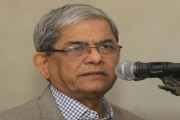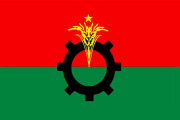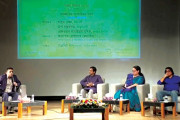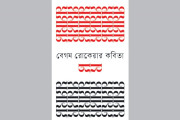– Humayun Ahmed’s Literary Landscape of Realism and Surrealism
।। Syed Raiyan Amir ।।
Humayun Ahmed, a prominent Bangladeshi author, playwright, and filmmaker, is renowned for his ability to seamlessly blend surrealism and realism in his literary works. His unique approach to storytelling transcends traditional boundaries, creating a distinctive narrative style that captivates readers and viewers alike. Here, I try to depict the ways Humayun Ahmed masterfully portrayed surrealism through realism in his extensive body of work. However, Humayun Ahmed, born in 1948, emerged as a literary giant in Bangladesh, leaving an indelible mark on the country’s cultural landscape. His novels, short stories, and movies often reflect a harmonious coexistence of the real and the surreal. His works, deeply rooted in the socio-cultural milieu of Bangladesh, exhibit an intricate interplay between the ordinary and the extraordinary.
Let us first have a glance at the ideas of Realism and Surrealism. Where they came from…
Literary realism emerged as a response to the extravagant narratives of romanticism in European literature and art from the late 18th to the mid-19th century. Centered in France, writers like Stendhal, Honoré de Balzac, and Gustave Flaubert depicted realistic portrayals of life, drawing from fields like biology, psychology, sociology, and the Industrial Age. Balzac’s La Comédie humaine, a series of interconnected writings, became an iconic work showcasing French reality. Realism extended beyond France, influencing European and American literature. In the United States, authors like William Dean Howells, Mark Twain, Stephen Crane, and Horatio Alger, Jr., presented realistic characters grappling with issues such as war, racism, materialism, and upward mobility. Notable American realist authors include John Steinbeck, Edith Wharton, Theodore Dreiser, and Upton Sinclair. While literary realism as a distinct movement waned around the mid-20th century, its impact persists. Modern writers continue to incorporate realistic elements into various genres, reflecting the enduring influence of early realist authors who shifted the literary focus away from romanticism.
In continuation, Realism in Bengali literature, as a literary movement that gained prominence in the late 19th and early 20th centuries, marked a departure from the romanticism that characterized earlier literary trends like the French one. It sought to depict life and society with a greater focus on reality, presenting a more accurate portrayal of the human condition. Several prominent writers contributed to the development of realism in Bangla literature.
One of the pioneering figures in introducing realism to Bengali literature was Bankim Chandra Chattopadhyay. His novel “Anandamath,” written in 1882, is considered a classic example of early Bengali realism. Through this work, he addressed social and political issues, depicting the struggles of characters within a historical context. The realist movement gained further momentum with the works of Rabindranath Tagore, who to some extent started many movements. Tagore’s stories and novels, such as “Gora” and “Chokher Bali,” delved into the complexities of human relationships, societal norms, and individual identity, reflecting a nuanced understanding of realism. Sharatchandra Chattopadhyay, another luminary of Bengali literature, made significant contributions to the realist tradition. His novels, including “Devdas,” “Parineeta,” and “Pather Dabi,” depicted the struggles of people from different walks of life, their aspirations, and the societal constraints they faced. His empathetic portrayal of characters resonated with readers and contributed to the popularity of realist literature in Bengal. Kazi Nazrul Islam, often hailed as the “Rebel Poet” of Bengal, infused realism into his poetry and writings. While he is known for his revolutionary spirit, Nazrul Islam’s works like “Bidrohi” and “Pralayollas” reflect a keen observation of social realities. His poems, with their passionate expressions, brought a unique dimension to Bengali realism. The later part of the 20th century witnessed the emergence of contemporary realist writers in Bengali literature. Sunil Gangopadhyay, with his novel “Atmaprakash,” explored existential dilemmas and the search for identity in a rapidly changing society. Suchitra Bhattacharya, a prominent female writer, addressed gender issues and familial relationships in her realist writings like “Kacher Dewal.” The works of Manik Bandopadhyay and Mahasweta Devi also stand out. Manik Bandopadhyay’s “Padma Nadir Majhi” depicted the struggles of fishermen in the Padma River, offering a stark portrayal of poverty and exploitation. Mahasweta Devi’s works, such as “Draupadi” and “Rudali,” focused on marginalized communities, bringing their harsh realities to the forefront. To me, the last prominence brought by Humayun Ahmed with his works, but that is not a mere reflection of only realism. That is a complex domain.
Surrealism, a post-World War I cultural movement, emerged in Europe with artists like Max Ernst, Salvador Dali, and Paul Clay pushing it forward. The movement, rooted in expressing subconscious activities through bizarre fantasies, aims to reconcile the conflict between dreams and reality. It originated from Dadaism, with French poet-critic André Breit leading the way. Surrealism, extending from poetry to other art forms, emphasizes the subconscious mind’s activity and is considered more real than reality. The movement, influenced by Freud’s psychoanalytic concept of unconscious desire, rejects overly rational thinking, embracing chaos and irrationality. Surrealists sought to liberate people spiritually and psychologically, using artistic techniques like psychological automatism and automatic writing. Despite facing challenges during World War II, surrealism persists in contemporary literature, pushing boundaries and prompting readers to think. Surrealist literature employs opposite images or ideas, Freudian free association, and poetic styles to delve into the subconscious, creating dream-like stories that defy logic. Examples from literature, including works by Stéphane Mallarme, T.S. Eliot, and James Joyce, demonstrate the enduring impact of surrealism. In Bengali literature, surrealism has been embraced by creators like Buddhadev Bose, Jibanananda Das, Shamsur Rahman, Shakti Chatterjee, and Joy Goswami, contributing to its vibrant expression. However, Humayun Ahmed’s creations stand apart, infusing fresh elements by combining surrealism within the realm of realism.
Let’s explore the “Surreal Threads in Humayun Ahmed’s Realism: Humayun Ahmed’s Literary Landscape of Realism and Surrealism”
Harmony of the Real and the Surreal
Humayun Ahmed’s brilliance lies in his ability to seamlessly weave the threads of realism and surrealism into a cohesive narrative fabric. His works often feature ordinary characters grappling with the complexities of everyday life, yet they find themselves entangled in situations that transcend the bounds of reality. This harmonious coexistence creates a literary landscape where the extraordinary emerges from the ordinary, and the mundane is imbued with a touch of magic. Consider Misir Ali as an example. In every story involving him, his initial entry is quite ordinary and realistic. However, the manner in which he processes his thoughts and assembles logical scenarios is entirely surreal. People typically engage with his intellect, embarking on a surreal journey through a very realistic logic. The derivation of logic, as observed with Misir Ali, appears somewhat supernatural. In the introduction of the book Anish, Humayun Ahmed wrote – “My point is that “logic” doesn’t care about acceptance, it goes its straight way. I used a four-line poem by Jalaluddin Rumi. This poem has nothing to do with the original book. This stanza of Jalaluddin Rumi is very dear to me. The temptation to give it to readers couldn’t resist the temptation to give it.” See, he wrote a story about logic, and use Rumi’s stanza in the beginning. This is what Humayun Ahmed is all about. A master of blending the real and surreal.
Magical Realism in Humayun Ahmed’s Novels
Magical realism, a genre characterized by the integration of fantastical elements into an otherwise realistic narrative, finds a comfortable home in Ahmed’s novels. All his notable works on Himu exemplify this genre. The protagonist, Himu, is an eccentric individual whose adventures often border on the surreal. Despite the fantastical nature of the plot, Ahmed grounds the narrative in the recognizable settings of Dhaka, allowing readers to navigate the magical and the mundane simultaneously. Himu has relatives, and these relatives sense a connection, but his emotions seem to hover between the realms of reality and surrealism. Despite residing in the city, he behaves like a man from the realm of the monks most of the time. He has house, but most of the times without furniture. He has his love, but without the sense of having it forever in real sense. And this is not the case of Himu only. Humayun Ahmed crafted his fictional character Shuvro as an exemplary figure for the audience. Shuvro, the sole offspring of an industrialist, is depicted in stories that radiate happiness due to the ideal mother-son relationship with Rehana. Yet, in certain series, the author places Shuvro in dilemmas and revelations to assess the purity of his soul. Notably, consider the name “White” in translation – what more could one ask from a writer.
Social Commentary through Surrealism
His use of surreal elements is not mere escapism; rather, it serves as a tool for social commentary. In “Deyal” (The Target), he explores the impact of political turmoil on individuals’ lives. The narrative is punctuated by dreamlike sequences, surreal occurrences, and symbolic imagery that enhance the emotional depth of the story. Moreover, his storytelling adeptly weaves surreal subjectivity into the fabric of realist objectivity. In “In Blissful Hell” (Nandita Narake), Humayun Ahmed explores the themes of social norms through the lens of Runu’s story. The narrative unveils the power dynamics prevalent in both societal and familial spheres, exposing the constraining subjectivity embedded in social norms that navigate personal freedom. Runu’s poignant lament, “They observe me from every angle, akin to hawks poised to swoop down on their target,” vividly captures the subjective nature of societal benchmark. Additionally, in works such as “Amar Achhe Jal,” the author delves into the intricate intersections of love, desire, and power within relationships. These novels intricately portray the complexities of emotional dynamics, societal expectations, and power struggles, providing a nuanced glimpse into relationships. By intertwining the surreal with the real, he provides a nuanced portrayal of the psychological and emotional toll of the society.
Humor as a Bridge between Realism and Surrealism
Humor is a prominent feature in Humayun Ahmed’s works, acting as a bridge between realism and surrealism. His iconic character, Baker Bhai, known for his absurd yet comical behavior, embodies this fusion. Baker Bhai’s antics inject humor into an otherwise serious narrative, showcasing the writer’s ability to use surreal elements to elicit laughter while addressing profound themes. Besides, the characters of Boro Chacha and Moti in “Aj Robibar” exemplify the genuine humor embedded in the writer’s storytelling prowess.
Exploring Meaning in the Realms of Meaninglessness
In his literary creations, Humayun Ahmed embarks on a profound exploration of the human quest for meaning and spiritual enlightenment. Within the tangible boundaries of reality, he navigates the essence of the soul’s search for purpose. Take “Darjar Opashe,” for instance, where Humayun guides readers through a transformative journey with Nishith, the protagonist, as he embarks on a spiritual odyssey in pursuit of solace and life’s intrinsic meaning. Within this narrative, Humayun intricately weaves threads of spirituality and self-discovery, exposing Nishith’s introspective reflections and his encounters with spiritual mentors, notably a wise old man imparting profound wisdom on life’s transitory nature. Nishith’s expedition stands as a poignant representation of the universal human yearning for transcendence, seeking meaning in the realm of the vacant. Similarly, in “Nishad,” Humayun delves into the psyche of Munir, a character grappling with the belief in multiple lives, challenging the conventional understanding of existence. This exploration further deepens the narrative’s engagement with the human search for meaning in the vast expanse of possibilities.
In the realm of Humayun Ahmed’s literary creations, characters navigate the borderlines between reality and the mysterious, encouraging readers to engage in reflections on existence and the quest for deep meaning — all within the context of the real world.
Conclusion
Humayun Ahmed’s portrayal of surrealism through realism in his works stands as a testament to his literary genius. His ability to navigate the complexities of human experience, infusing ordinary lives with extraordinary elements, has left an enduring impact on Bengali literature and culture. Through a harmonious blend of the real and the surreal, he has created a literary legacy that continues to resonate with readers and viewers alike, inviting them to explore the intricate tapestry of the human condition.
Syed Raiyan Amir is a research associate at the KRF Center for Bangladesh and Global Affairs (CBGA).










































































































































































